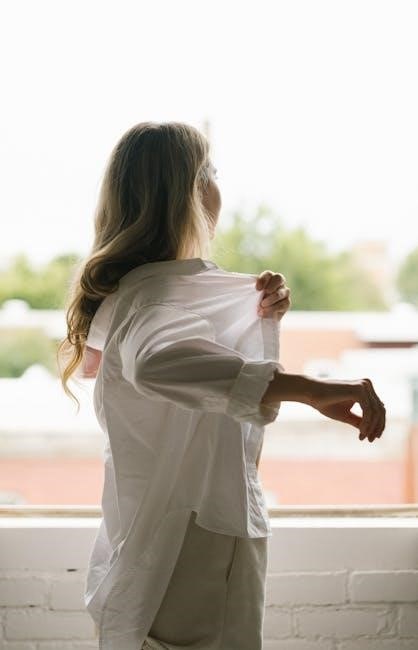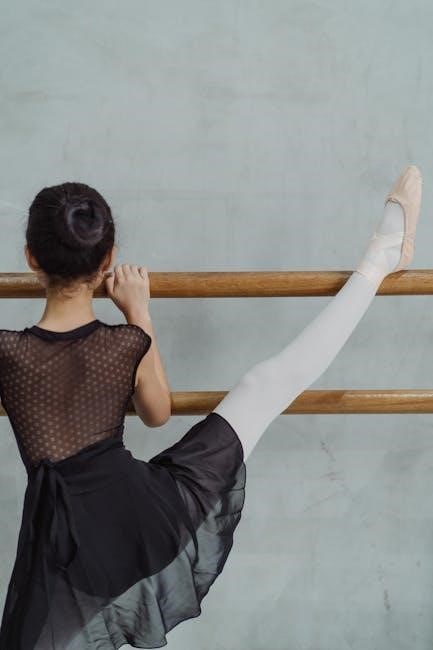
Hemi dressing techniques enable individuals with hemiparesis to achieve independence in dressing. These methods focus on adapting movements for both upper and lower body clothing‚ emphasizing the use of adaptive tools and guidance from occupational therapists to enhance confidence and self-reliance.

Definition of Hemi Dressing
Hemi dressing refers to specialized techniques designed for individuals with hemiparesis‚ often resulting from stroke or brain injury‚ to enable independent dressing. These strategies focus on adapting movements to accommodate limited mobility on one side of the body. The techniques emphasize the use of adaptive tools and methods to simplify dressing tasks‚ such as using one-handed methods or adaptive clothing. Occupational therapists play a key role in tailoring these techniques to individual needs‚ ensuring maximal independence and confidence. Hemi dressing is a vital skill for promoting self-reliance and maintaining dignity in daily life.

Importance of Hemi Dressing for Individuals with Hemiparesis
Hemi dressing is crucial for individuals with hemiparesis‚ as it promotes independence and self-esteem. By mastering these techniques‚ individuals can perform daily dressing tasks without relying heavily on caregivers‚ fostering a sense of autonomy. This skill enhances overall quality of life‚ allowing individuals to maintain dignity and confidence. Hemi dressing also reduces frustration and anxiety associated with limited mobility‚ making daily routines more manageable. Adaptive tools and techniques tailored to individual needs further support this process. Occupational therapists play a vital role in guiding and empowering individuals‚ ensuring they can dress safely and efficiently‚ which is essential for long-term well-being and self-reliance.
Step-by-Step Hemi Dressing Techniques
Mastering hemi dressing involves systematic steps to simplify the process. Start with the unaffected side‚ using adaptive tools to aid in clothing management. Practice consistent sequences to build confidence and independence in daily routines.
Upper Body Dressing Techniques
Upper body hemi dressing focuses on methods to manage shirts‚ jackets‚ and pullovers. Start with the unaffected arm‚ using it to guide clothing onto the affected side. For shirts‚ place the garment face down on your lap‚ insert the unaffected arm first‚ then lean forward to pull it over your head. Use one hand to fasten front openings‚ as they are easier to manage. Adaptive tools like buttonhooks can assist with buttons. When removing shirts‚ start with the unaffected arm and gently pull the garment over the head. Practice these sequences to build independence and confidence in upper body dressing.
Lower Body Dressing Techniques
Lower body hemi dressing techniques focus on managing pants‚ underwear‚ and socks. Start by sitting on a firm chair or using a stool for support. To put on pants‚ use the figure 4 position: cross the affected leg over the strong leg‚ then pull pants up with one hand. For socks‚ use the figure 4 position again or employ the 3-finger technique to slide them on. Adaptive tools like a dressing stick or long-handled reacher can assist with pulling up pants or socks. Practice these methods to improve efficiency and maintain independence in lower body dressing tasks.

Adaptive Equipment for Hemi Dressing
Adaptive tools like buttonhooks‚ dressing sticks‚ and sock aids simplify hemi dressing. These devices help individuals with limited dexterity to manage clothing independently‚ enhancing dressing efficiency and confidence.

Commonly Used Adaptive Tools
Commonly used adaptive tools for hemi dressing include buttonhooks‚ long-handled reachers‚ sock aids‚ and dressing sticks. These devices assist with tasks like fastening buttons‚ pulling up socks‚ and managing clothing. Buttonhooks help with buttoning shirts‚ while reachers aid in retrieving items. Sock aids simplify putting on socks without bending‚ and dressing sticks help with zippers and pulling pants up. These tools enhance independence and make dressing easier for individuals with limited mobility. They are often recommended by occupational therapists to optimize daily dressing routines and improve overall efficiency. Adaptive tools play a crucial role in empowering individuals with hemiparesis to dress independently.
How to Effectively Use Adaptive Equipment
To effectively use adaptive equipment for hemi dressing‚ start with simple tasks and gradually incorporate tools as needed. Use a buttonhook for buttons‚ a dressing stick for zippers‚ and a sock aid for socks. Practice each step slowly to build confidence. Occupational therapists can demonstrate proper techniques and recommend the most suitable tools. Consistency and patience are key. Regular practice helps master the use of adaptive equipment‚ ensuring independence and efficiency in daily dressing routines. Always follow the guidance provided in instructional handouts or videos to maximize the benefits of these tools.
Role of Occupational Therapists and Caregivers
Occupational therapists guide individuals with hemiparesis in mastering hemi dressing techniques‚ while caregivers provide emotional and practical support‚ fostering independence and confidence in daily tasks.

Guidance from Occupational Therapists
Occupational therapists play a vital role in teaching hemi dressing techniques‚ offering personalized strategies to overcome physical limitations. They demonstrate step-by-step methods for upper and lower body dressing‚ emphasizing the use of adaptive tools like buttonhooks and dressing sticks. Therapists also provide resources such as PDF handouts and video tutorials‚ ensuring individuals and caregivers understand proper techniques. By focusing on independence and confidence‚ they help individuals with hemiparesis master daily dressing tasks effectively‚ adapting methods to suit individual needs and promoting self-reliance in personal care.
Assistance and Empowerment for Caregivers
Caregivers are essential in supporting individuals with hemiparesis during dressing. Occupational therapists provide caregivers with tailored strategies to assist effectively without undermining the individual’s independence. Resources like PDF guides and video tutorials offer practical tips‚ ensuring caregivers understand proper techniques. Emotional support is also crucial‚ as caregivers help build confidence and self-esteem. By fostering a collaborative environment‚ caregivers empower individuals to participate in dressing tasks‚ promoting a sense of control and dignity. Therapists emphasize the importance of allowing individuals to perform as much as they can independently‚ ensuring caregivers strike the right balance between assistance and encouragement.

Resources for Hemi Dressing
Downloadable PDF guides and video demonstrations provide step-by-step instructions for hemi dressing techniques. The Occupational Therapy Toolkit offers comprehensive handouts‚ enhancing learning for both patients and caregivers.

PDF Handouts and Guides
PDF handouts and guides are essential resources for mastering hemi dressing techniques. The Occupational Therapy Toolkit provides detailed‚ downloadable PDFs that include step-by-step instructions‚ visual aids‚ and practical tips. These guides cover both upper and lower body dressing‚ offering methods to simplify tasks like putting on shirts‚ pants‚ and socks. They often include sections on adaptive equipment usage and caregiver assistance. Many handouts are designed to be printed‚ making them accessible for daily practice. By following these structured guides‚ individuals with hemiparesis and their caregivers can learn efficient dressing techniques‚ promoting independence and confidence in daily routines.
Video Demonstrations and Tutorials
Video demonstrations and tutorials are invaluable for learning hemi dressing techniques. Platforms like YouTube offer step-by-step guides‚ such as the “Hemi work out with cane” and “Upper body dressing technique” videos. These tutorials provide visual instruction on methods like the figure-4 position for putting on socks and shirts. Many videos are created by occupational therapists‚ ensuring accurate and practical advice. They often include tips on using adaptive equipment‚ such as dressing sticks or sock aids. By watching these videos‚ individuals with hemiparesis and caregivers can practice techniques in real time‚ enhancing their skills and confidence in daily dressing routines.

Common Challenges and Solutions

Individuals with hemiparesis face challenges such as limited dexterity‚ balance issues‚ and fatigue during dressing. Solutions include using adaptive equipment‚ structured routines‚ and practicing techniques to enhance independence and confidence.
Overcoming Dressing Challenges
Individuals with hemiparesis often struggle with dressing due to limited mobility and dexterity. Techniques like the figure-4 position for putting on socks and using a dressing stick can simplify tasks. Breaking dressing into smaller‚ manageable steps helps build confidence. Adaptive tools‚ such as buttonhooks and zipper pulls‚ reduce frustration. Practicing in front of a mirror provides visual guidance‚ while seated dressing can improve balance. Setting up clothes in advance and using Velcro closures minimizes effort. Patience and regular practice are key to mastering these strategies‚ enabling greater independence and self-reliance in daily dressing routines.
Practical Solutions for Daily Dressing
Individuals with hemiparesis can benefit from practical strategies to simplify dressing. Using adaptive tools like buttonhooks‚ dressing sticks‚ and sock aids reduces difficulty. The figure-4 position helps with putting on socks‚ while seated dressing improves balance. Pre-laying out clothes in the same sequence daily saves time and effort. Incorporating front-fastening clothing and elastic waistbands minimizes the need for complex fastenings. Techniques like “one-handed tying” and using Velcro closures further enhance independence. Establishing a consistent daily routine and enlisting caregiver support when needed fosters confidence and makes dressing more manageable‚ enabling individuals to maintain their independence and dignity in daily life.
Hemi dressing techniques provide individuals with hemiparesis the tools to regain independence in daily dressing. By mastering strategies like one-handed methods‚ using adaptive equipment‚ and following step-by-step guides‚ individuals can overcome challenges. Occupational therapists and caregivers play a vital role in offering personalized support. Resources such as PDF handouts and video tutorials further empower individuals to practice effectively. Consistency‚ patience‚ and the right tools foster confidence and self-reliance. With these approaches‚ individuals can achieve greater autonomy‚ enhancing their overall quality of life and dignity. Thank you for exploring hemi dressing techniques—may this knowledge bring independence and ease to daily routines.